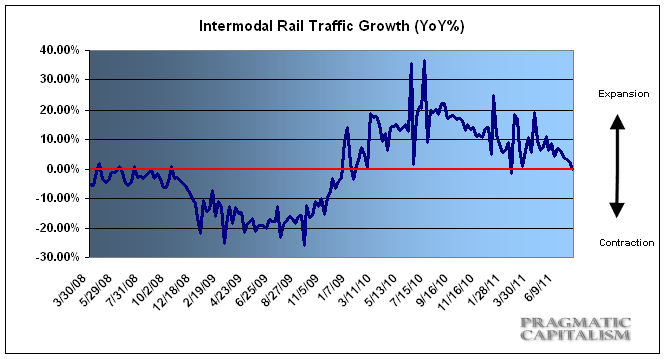The latest data on rail traffic from the AAR showed a decline in total carloads and intermodal traffic. Carloads were down -3.2% while intermodal traffic declined -0.25. This is only the second negative reading in the last 18 months. Historically, sustained downturns in rail traffic have tended to lead recessions. We’ll be keeping a close eye on this indicator in the coming months to decipher whether this is a sustained trend or a blip on the radar. The AAR has the details on this week’s report:
“The Association of American Railroads (AAR) today reported a decrease in weekly rail traffic, with U.S. railroads originating 245,574 carloads for the week ending July 9, 2011, down 3.2 percent compared with the same week last year. Intermodal volume for the week totaled 192,619 trailers and containers, down 0.2 percent compared with the same week last year.
Thirteen of the 20 carload commodity groups posted increases from the comparable week in 2010. Commodity groups posting solid increases included: iron and steel scrap, up 32.5 percent; metallic ores, up 22.9 percent; and all other carloads, up 14.6 percent. Groups posting notable decreases included: waste and nonferrous scrap, down 16.1 percent; coal, down 11.3 percent; and grain, down 10.5 percent.
Weekly carload volume on Eastern railroads was down 1.3 percent compared with the same week last year. In the West, weekly carload volume was down 4.2 percent compared with the same week in 2010.
For the first 27 weeks of 2011, U.S. railroads reported cumulative volume of 7,784,801 carloads, up 2.5 percent from last year, and 6,048,752 trailers and containers, up 7.5 percent from the same point in 2010.”
Source: AAR
Mr. Roche is the Founder and Chief Investment Officer of Discipline Funds.Discipline Funds is a low fee financial advisory firm with a focus on helping people be more disciplined with their finances.
He is also the author of Pragmatic Capitalism: What Every Investor Needs to Understand About Money and Finance, Understanding the Modern Monetary System and Understanding Modern Portfolio Construction.


Comments are closed.